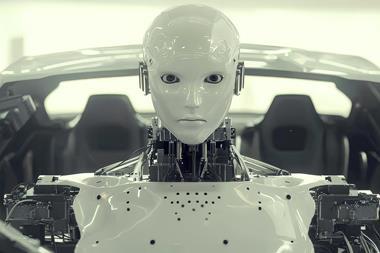Vehicle-makers are introducing more wearable equipment to alleviate stresses and strains, giving assembly workers a somewhat cyborg look. AMS reports on the latest innovations being rolled out by Audi and BMW As the robots used in automotive manufacturing become more human, able to work collaboratively and intelligently, in one sense human operatives are becoming more machine-like. Wearable technology such as ‘medical’ gloves or scanner gloves, plus exoskeletons for the upper and lower body are starting to give line workers a distinctly cyborg look. Of course, it’s not about aesthetics but ergonomics; the alleviation of stresses and strains plus the fatigue which makes errors more likely, therefore improving production efficiency and quality.
As the robots used in automotive manufacturing become more human, able to work collaboratively and intelligently, in one sense human operatives are becoming more machine-like. Wearable technology such as ‘medical’ gloves or scanner gloves, plus exoskeletons for the upper and lower body are starting to give line workers a distinctly cyborg look. Of course, it’s not about aesthetics but ergonomics; the alleviation of stresses and strains plus the fatigue which makes errors more likely, therefore improving production efficiency and quality.
In March this year, BMW announced the “persistent modernisation” of its working environments to “further reduce ergonomically unfavourable and strenuous tasks, giving workers an opportunity to apply their unique cognitive skills to the best effect”. The company said this process would involve the use of lightweight robots, smart devices and exoskeletons to create a “leaner and more adaptable” production system.

The OEM already uses exoskeletons in assembly but will boost the number of upper-body supports from 24 to 64 in 2017. This is a response to high demand at the Spartanburg plant, South Carolina, which operates the existing 24 devices and has a history of “innovative value creation”, says Christian Dahmen, specialist for exoskeletons in production, BMW. “We tested the exoskeletons in Spartanburg in a pilot project in 2016 and got them ready for use in series production,” he states. “Following the consistently positive experience in Spartanburg, the next step will be rollout at our German automotive plants.”
He describes the upper-body support as being like a T-shirt, available in different standard sizes but modifiable for specific requirements. BMW has worked with both major manufacturers and small start-ups to develop the exoskeletons and Dahmen says that weight, wearing comfort and the time it takes to put on or remove them are important considerations, alongside the operational advantages they deliver. “The material mustn’t chafe, create pressure points or cause excessive sweating, and can’t be too heavy,” he explains.
This is one reason why BMW uses ‘passive’ upper-body exoskeletons which rely on mechanical springs rather than servomotors to support the arms. “This saves weight and makes the exoskeleton more comfortable to wear for longer periods,” states Dahmen. Acceptance among personnel is critical to the effective deployment of the devices, and so BMW is careful to consult its workers from the conceptual design phase through pilot projects to implementation. According to Dahmen, the company is currently exploring other applications for its exoskeletons.
“People are more than ever becoming the designers of their own workplaces” – Christian Dunckern, BMW
BMW already uses a lower-body support at its German plants. Consisting of moveable splints attached to the torso or legs which can be locked into different positions, the structure transforms prolonged standing into sitting and helps workers completing tasks such as cockpit pre-assembly, where little walking is required. However, in its March announcement, the OEM did not specify an increase in the 11 lower-body exoskeletons currently in use. “With new assistance systems, we always focus on the benefits: will an exoskeleton help staff perform a specific work task in a more ergonomic position? Employees confirm that the reduction in strain is particularly noticeable for overhead tasks,” explains Dahmen.
 The Chairless Chair is hydraulically adjustable
The Chairless Chair is hydraulically adjustableThe chair that’s not a chairBMW’s premium-brand rival, Audi, calls its lower-body exoskeleton the ‘Chairless Chair’. Developed in collaboration with Swiss start-up Noonee, it comprises a carbon-fibre reinforced plastic (CFRP) frame strapped to the back of the legs at the hips, knees and ankles. The contoured CFRP struts are jointed behind the knee and can be hydraulically adjusted according to body size and desired sitting position, while two leather-covered surfaces support the buttocks and thighs like a seat. Although the chair weighs only 2.4kg itself, it is able to transfer the entire body weight of a person to the floor. Since the struts are moveable, personnel can choose to alternate between sitting and standing while completing their work.
At the end of last year, Audi completed an eight-week trial of the device involving more than 40 test subjects at Neckarsulm and Ingolstadt, Germany. “The goal of the pilot project was to find out if the employees would accept the Chairless Chair long term and to gain insight into positive effects the Chairless Chairs have on reducing strain,” states Mathias Keil, head of industrial engineering methods development at Audi. He says that potential improvements which emerged from the project focused on “wearing comfort, reduced weight and an optimised seat cushion”, and that these have now been implemented by the manufacturer of the support.
A further pilot project is being carried out at Audi’s engine plant in Győr, Hungary, which will place different demands on the chair compared with vehicle production. At the same time, the OEM is working with the University of Tübingen, Germany, to examine the occupational health benefits of the device and validate its ergonomic benefits. “After that, the rollout of the Chairless Chair as an ergonomic aid is planned in the VW Group, which we are supporting with our expertise from the pilot projects,” says Keil. The Chairless Chair will make its debut in Audi’s series production at Ingolstadt and Neckarsulm during 2017.
Moreover, Audi is looking at developing similar support for the upper body, which Keil says may involve an ‘active’ exoskeleton, and a feasibility study is currently underway at the Fraunhofer Institute, which has created ‘Stuttgart Exo-Jackets’. The ergonomic potential of these devices is now being tested at sample workplaces under laboratory conditions.
Getting a handle on smaller strainsAnother Audi initiative soon to be expanded to the VW Group are the ‘medical’ gloves which were trialled in late 2015 using 1,000 assembly workers at Ingolstadt and Neckarsulm, Győr, and Brussels, Belgium. The gloves were developed in partnership with orthopaedic technology company Spörer and the top priority during this process was “to ensure high wearing comfort with maximum flexibility in use”, explains Keil. He says that employee feedback from the pilot project “specifically concerned the design of the padding and increasing wearing comfort”.
The final product features an ‘anti-impact’ area made of Teflon for durability, an elastic fastener around the wrist to provide stability and absorbent foam which reduces the compressive strain on the palm and edge of the hand by 52%. Given that Audi’s car-door assembly workers can fit 300 trim strips per shift, alleviating this strain is clearly important. The devices are now used at the four pilot plants for the installation of decorative trim, tailgate liners and sill trim.
In 2015, Ford announced that it had managed to reduce the number of injuries among its 50,000-strong workforce by an impressive 70% since 2003, thanks to new ergonomics research, workstation redesign, “data-driven process changes” and the use of equipment such as lift assists. As reported by AMS, this work has resulted in a 90% drop in ergonomic problems such as overextended movements, restricted hand clearance and difficult installations. Much of this progress was achieved by moving ergonomics from a reactive to a proactive strategy through the use of virtual modelling to build a detailed picture of the stresses and strains likely to confront personnel on the production line.
 Audi uses virtual technology to improve real-life assembly
Audi uses virtual technology to improve real-life assemblySimilarly, in late 2015, Audi reported that it has been testing gesture control for virtual assembly aimed at improving real-life operations. In a Cave Automatic Virtual Environment (CAVE), a combination of projectors and projection surfaces on the walls and floor is used to display 3D images of components, controllable through simple movements detected by a Bluetooth-enabled armband. The band sends motion data to a computer, which also tracks the user’s position via an infrared camera on the ceiling. Audi is now introducing actual objects, such as screwdrivers and 3D-printed parts into this virtual environment.
"By using real parts with the correct weight distribution and size in combination with the virtual world we gain a new dimension of realism that facilitates our decision of whether changes are needed for the benefit of ergonomics,” explains Michael Günter, engineer digital process validation at Audi. “Being able to do that in an early phase [of product development], because we are not reliant on the complete vehicle already being built, changes can be made more quickly and cost efficiently. This directly affects the ergonomics our colleagues experience on the assembly line.” He says that these initial tests have generated “promising results” and that Audi plans to use this technique from the end of 2017.
 Audi has introduced 'medical' gloves to reduce hand strain
Audi has introduced 'medical' gloves to reduce hand strainThe devices were developed in collaboration with the manufacturers until both the glove and the scanner met BMW’s key requirements, which Schmidt specifies as “wearing comfort” and “fast, simple operation”. The gloves were first introduced at the OEM’s German plants and around 400 workstations have so far been equipped with scanner gloves, though Schmidt says the international rollout is “not yet complete”.
As BMW pushes forward its “persistent modernisation” with more ergonomics equipment, smart devices and robotics, the company is careful to keep the human element foremost in its plans. Speaking in March, Christian Dunckern, head of BMW Group Production System, Planning, Toolmaking and Plant Engineering, noted that “the people who actively shape our production system on a daily basis” are the ones best qualified to judge the added value of the technology which “expands their creativity and efficiency”. And so, despite the cyborg look, power remains with humanity: “People are more than ever becoming the designers of their own workplaces and can provide answers to the questions of an increasingly complex automotive production.”




































